Future Now
The IFTF Blog
Why We Communicate
Illustrations by Jacob Glaser
Intentions in a world of ambient communications
We are on the verge of a set of technological advances that will transform when, where, how, and why we communicate. The Internet of Things, advances in network speed, and emerging immersive media platforms are transforming our communications experiences. Communications infrastructure will be embedded into our physical world, with messaging and interactions that adapt to contextual needs and anticipate future moves in order to grab our attention. Flat visual interfaces will give way to experiences that engage our whole bodies in multisensory ways, illuminate invisible patterns, and enable us to program our communications streams and orchestrate massive computation resources with just a few casually spoken words.
This communications infrastructure will seamlessly merge our digital and physical worlds to add layers of meaning and responsiveness to human-to-human, machine-to-human, and machine-to-machine interactions. The next decade will usher in a world of ambient communications that will challenge us to radically rethink our communications strategies.
Familiar Intentions, New Experiences
To unlock the value of these emerging technological capacities, we need to understand how to connect them to familiar human intentions.
In this issue of Institute for the Future’s Future Now, we explore how these technological capacities will intersect with long-standing intentions of communication through a series of scenarios, articles, interviews and other provocations. Collectively, they explore issues like how powerful new technologies of surveillance can be used for everything from making games more fun and engaging to maintaining intimate relationships between family members. We look at how sensors, artificial intelligence, blockchain, and blended reality tech will transform how we collaborate, allowing massive crowds to work together in emergent ways, and even allowing us to partner with animals and digital entities in new ways. As you explore the pieces organized across this range of eight intentions—fun, persuasion, collaboration, productivity, control, engagement, empathy, intimacy—look for specific strategies and combinations of technologies that can best serve an intention.
Visions of Ambient Communications
Shifts in our communications technologies accompany shifts in our typical, everyday practices. In just the past decade, now-familiar images of teenagers becoming celebrities in their bedrooms, street protesters reaching global audiences, and mobile knowledge workers turning any place into office space have gone from being difficult to imagine to so familiar they’re almost mundane.
In the pages that directly follow, you’ll find comics set in the year 2026 that will immerse you in this soon-to-be familiar landscape. From popstars using digital holograms as brand ambassadors to intelligent furniture that bonds families across distances, these scenes point to the kinds of communication experiences that will stretch your sense of possibility but will seem unremarkable a decade from now.
Technologies That Matter
New capacities of ambient communication experiences
Looking out to the year 2026, we see a ubiquitous, all-encompassing communications infrastructure that seamlessly merges our digital and physical worlds. This infrastructure combines configurable wireless networks, embedded sensors, cloud computing, and artificial intelligence that adds layers of meaning and responsiveness to human-to-human, machine-to-human, and machine-to-machine interactions.
These and other foundational technologies are combining in novel ways to create five new capacities of ambient communications that provide the infrastructure of the media experiences we will create to fulfill our intentions.
Embedded From extrinsic to intrinsic
Computation is a three-part act: accept an input signal, process the signal, and output the result. Computation has gotten cheaper, faster, and smaller over the decades. We’ve gone from multi-ton, multimillion-dollar mainframes in the mid–20th century to $300 wristwatches embedded with a microphone, altimeter, accelerometer, gyroscope, optical pulse sensor, ambient light sensor, touch sensor, microelectromechanical system actuator, gigabytes of storage, and wireless Internet. Now imagine the functions of a smartwatch embedded into everything from eyewear to clothing to cereal boxes, eventually even into our bodies. In the coming years, the combined trends of Moore’s Law and sensor fusion will enable the proliferation of tiny super machines connected by configurable mesh networks, embedded with artificial intelligence, sensors, and local data sets. These will generate and summarize metadata, perform translation and local analytics, and enable an immersive communications experience that’s ubiquitous, hyperaware, and invisible.
Illuminated From heuristic to optimal
Yesterday’s home thermostats used timers as non-optimal best guesses to control room temperature. Today’s smart thermostats learn about the changing behavior of a building’s occupants to establish an optimal temperature schedule. The next decade will see the rise of smart things that collect and analyze multiple streams of data to unveil previously hidden troves of understanding. Improvements in pattern recognition, computer vision, and artificial intelligence technology will shine a light on the dark matter of our individual and group behavior. AIs and robots will learn from us—and from each other—and will begin telling us new things about our homes, bodies, cities, and personalities. We’ll tune into any combination of many layers of pervasive augmented realities, allowing us to see formerly invisible patterns, which will help us—and our automated proxies—make better decisions about our work schedules, travel plans, health regimens, and financial investments.
Anticipatory From reactive to proactive
Deeply linked information streams and improved machine intelligence are giving computational systems the ability to anticipate our needs and deliver advice and information in a timely and context-appropriate manner. For instance, applications such as Google Now scan our email for package deliveries, appointments, and interests to create highly personalized reports of actionable information. In the next decade, everything visible and tangible in immersive experiences will be activated, enriched, and supported by machine intelligence in ambient communications networks. Networks will make use of advanced deep learning to combine and analyze unstructured big data sets and construct computer-based models of the world. They will spot patterns within large data sets and infer what action may occur or be most effective. Such networks have the potential to craft messaging specifically to individuals or to identify trends even before they achieve conscious awareness among humans.
Multisensory From visual to embodied
For decades, computational output was limited to visual data—blinking lights, words punched onto teletype paper, green phosphor shapes floating across screens. Graphics grew more sophisticated and were joined by sounds. Today, we experience synthetic realities at resolutions rivaling the real world. Until recently, this high-fidelity communication was limited to outputs—people could input information only by entering machine-readable characters one at a time. Now computers are acquiring sensory organs, making natural forms of input possible. Siri and Alexa are ears connected to a natural-language system that hears what we need and delivers it digitally or orders it shipped. Google Glass and other smart eyewear devices see things we’re looking at, including things we don’t notice, and provide contextual information. Ambient-communications networks will engage our entire body by becoming more responsive to voices, gestures, emotional states, skin, and eventually thoughts. With holographic displays and haptic interfaces, our media won’t merely connect with us, they will envelop us.
Programmable From solo to symphony
On their own, each of these emerging technology capacities will advance ambient-communications experiences. When orchestrated collaboratively around the world, using distributed automated workflows and high-speed fiber interconnection, and mediated by intelligent agents, they’ll effect a tremendous social transformation. Interfaces will customize themselves for the user through machine learning. Blockchain technology will become integrated into devices and networks to conduct transactions and generate records, allowing us to autonomously transact on a peer-to- peer basis with every entity from friends, doctors, and financial advisors to trusted AIs. Every person, thing, place, idea, and media object will have one or more intelligent layers of data. Configurable device protocols will connect these layers through a common language, enabling new information systems to flourish. We’ll enlist an array of machine-based systems to carry out our intentions. Because of their varied utility, ambient-communications networks will be adopted even more rapidly than preceding information technologies.
The SHOPPER and the BRAND
Step into a world where business-to-consumer communications gets personal. Here, shoppers get personalized advice from a humanoid chatbot in hologram form. In fact, they receive counsel from multiple bots, each representing a different desire the shopper has, from frugality to well-being, and from environmental responsibility to novelty. In this near-future world, shopbots are developed and deployed by
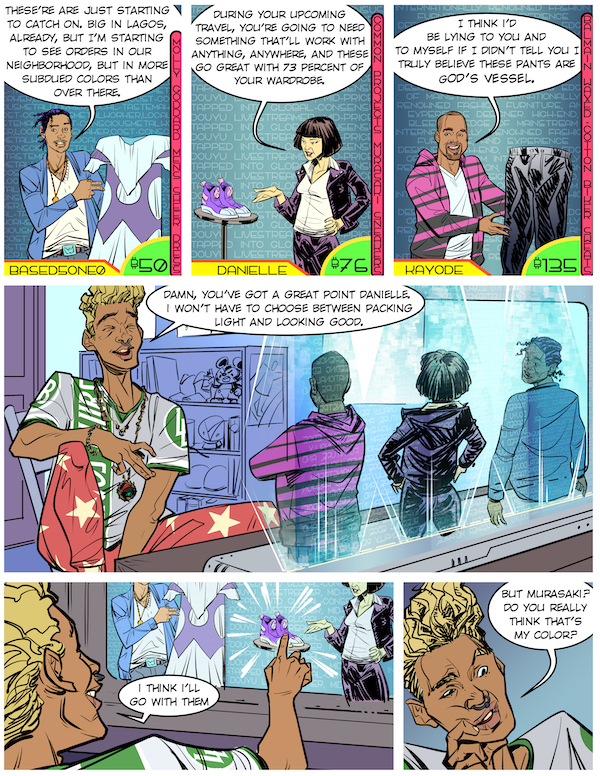
influential people, publications, and brands, providing recommendations in exchange for a cut of each sale. The more you buy, the more their owners make. But this creates a dilemma—bot owners can use data-driven insights to push the products consumers are most likely to purchase, but if they stray too far from their brand identity, they might undermine the trust that made them an authority in the first place.
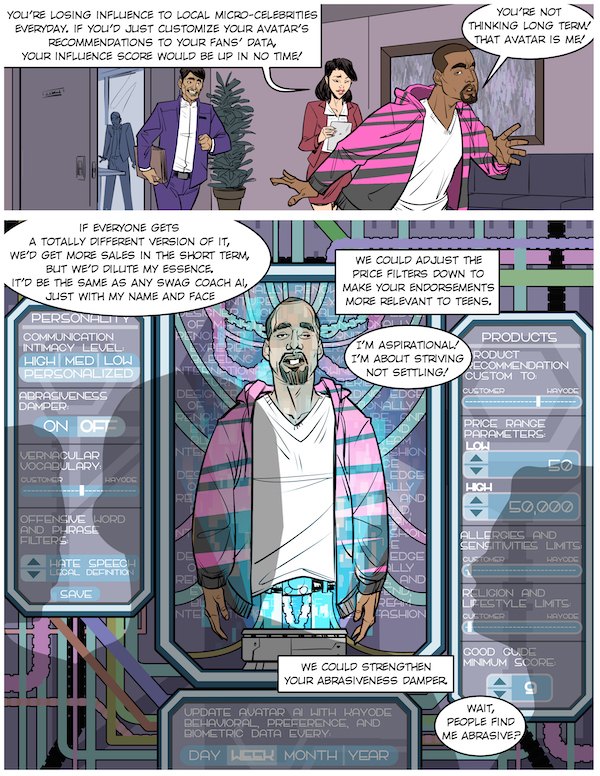
The WORKER and the OUTLAW
Ever felt like you’re just another cog in the machine? Well, in this world you’re a subroutine. Here, workers receives task requests at all times of the day and communicate through a platform. An “employee” might never see or speak directly to their “boss.” And for project managers (both legit and criminal) getting things done means building "recipes" that string together platforms, tasks, and people. When one
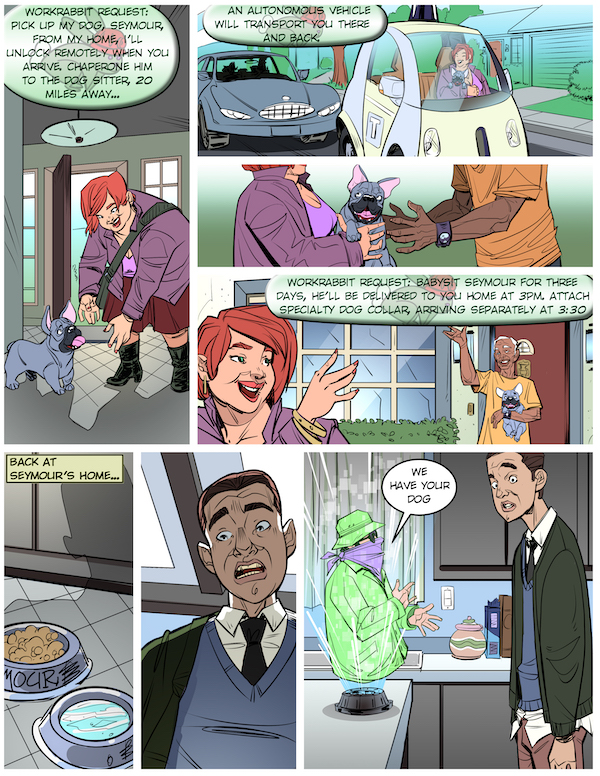
worker completes a task, it triggers a new worker to start the next task in the recipe. These recipes ensure everyone does their part in a particular sequence, resulting in a coherent outcome, without individual contributors ever needing to see the whole. The next time you accept a task in the platform economy, you may not know which cog...er...person you’re collaborating with—or what you’re an accomplice to.
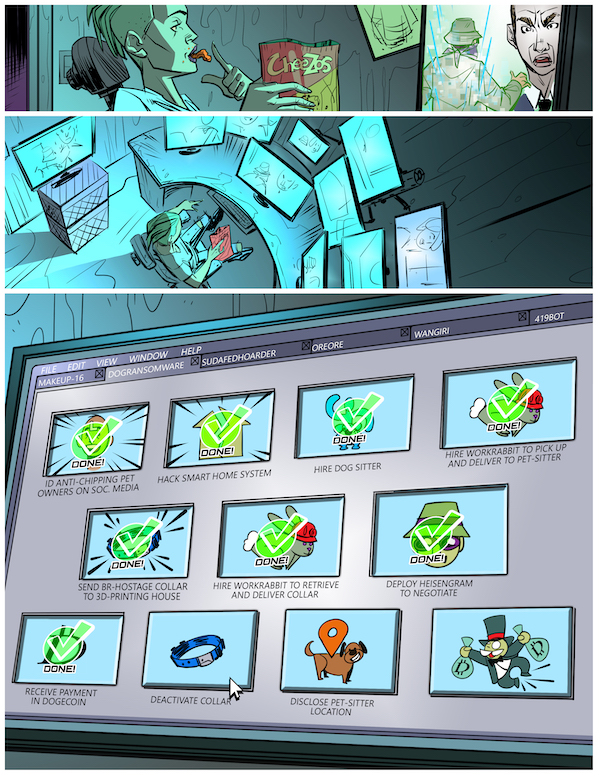
The FAMILY and the NOMAD
Today, a live-in assistant is too costly for most families, at least in the United States. But what if that assistant was an app? Welcome to a world where intelligent digital agents like Siri are embedded into furniture and kitchen counters, interacting with the entire household. These family assistants do more than recite recipes or driving directions. They plan a key role in keeping the family connected, mediating
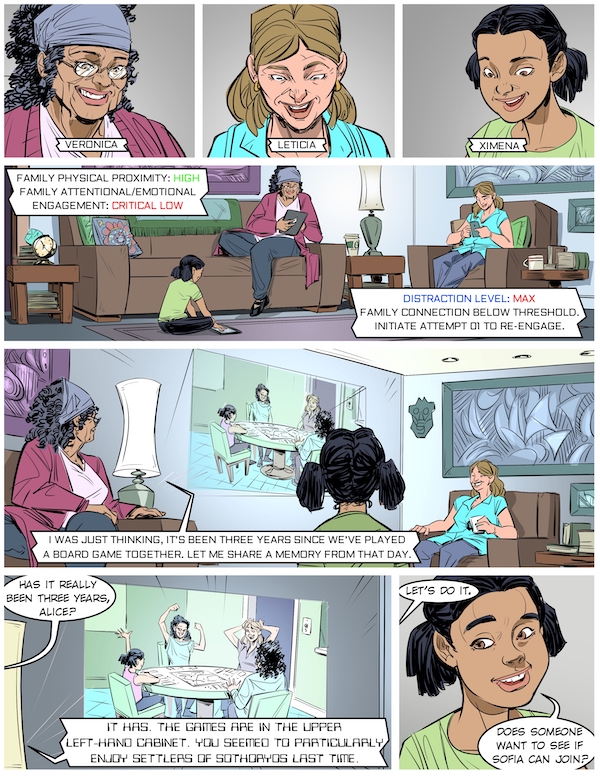
conflicts, and coordinating schedules for activities outside the home. In this future, work and learning are much more improvisational than they were in 2016. Fewer events and opportunities occur at fixed times and locations. Everything is ad hoc and on-the-go. As always, the younger generation is creating new approaches to navigating space and time. The rest of us will have to learn to keep up.
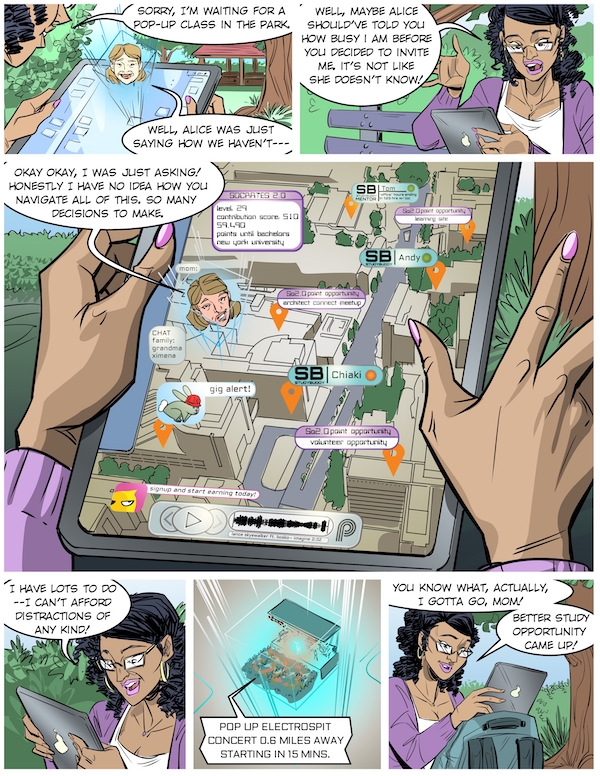
The ACTIVIST and the POLITICIAN
No matter what you’re interested in, there’s a social-media personality you can turn to for information and entertainment. Activists can learn a lot from livestreaming stars when it comes to engaging and growing audiences around the issues they care about. In this future, activism is as much about presenting evidence as it is telling compelling stories. And sensors and software that collect and analyze environmental and behavioral data will play a key role in creating stories that move us.
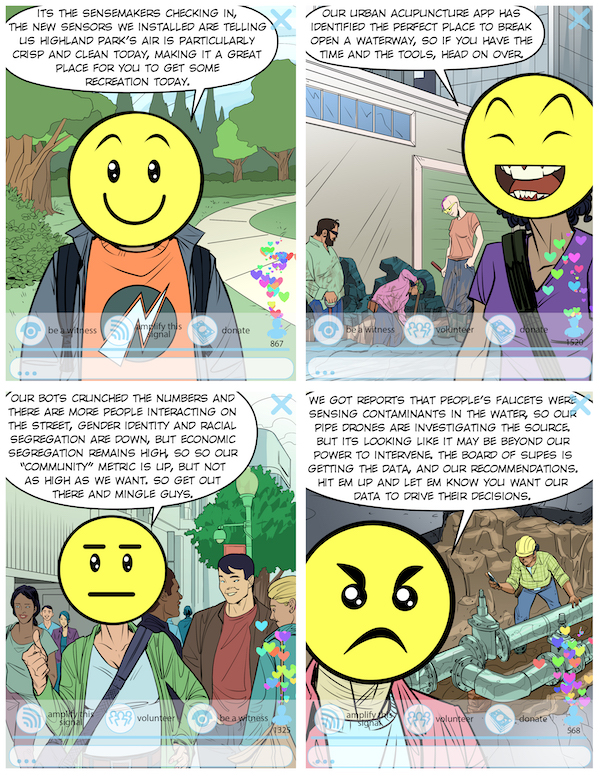
Politicians, meanwhile, get unprecedented access to data about their constituents and their needs. But the data isn’t reported as numbers on a spreadsheet or words on a page—it’s used to generate complex simulations that model the results of their policy proposals.
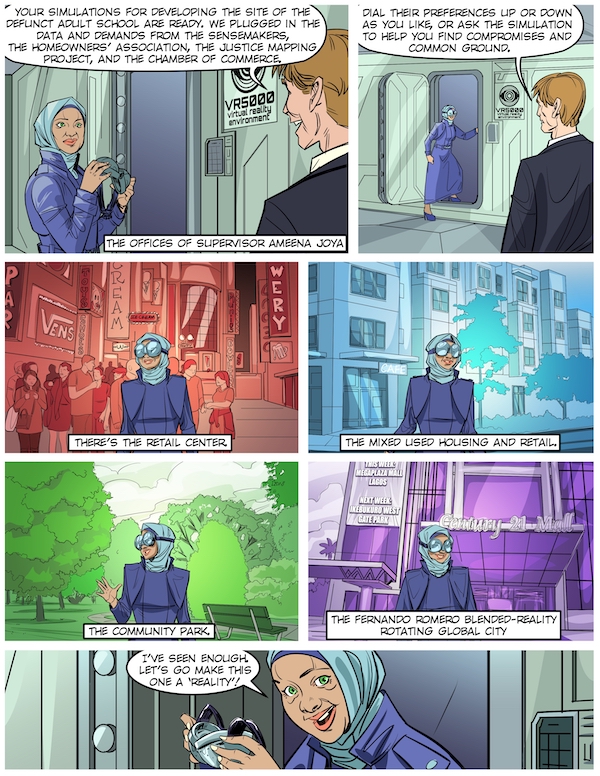
The ATHLETE and the REFUGEE
Front-row seats are the most coveted vantage point to view a sporting event. But what if you could experience an event from the athlete’s point of view? In this future, drones capture the action from the best angle, and sensors record smells, sounds, and sensations, allowing anyone to share the athlete’s experience with unprecedented intimacy.
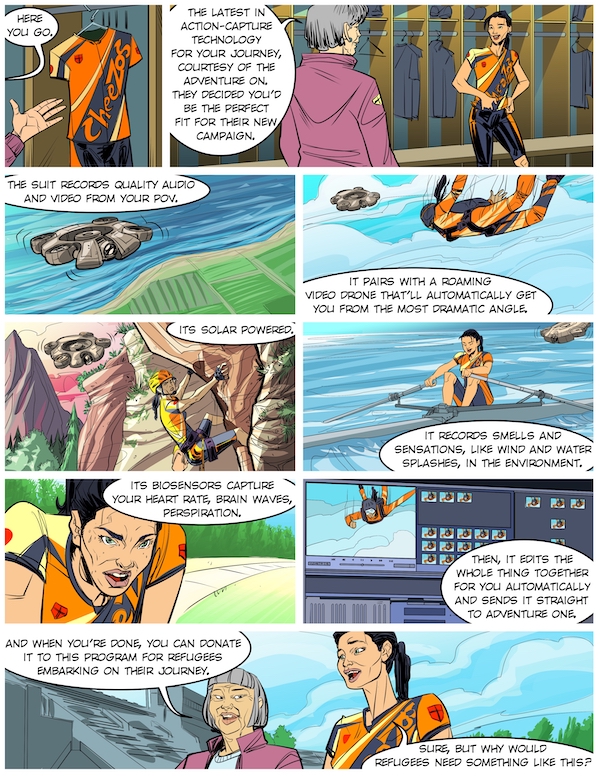
But capturing an immersive experience isn’t always about fun. Journalist Ghaith Abdul-Ahad remarked that refugees often perform feats of extreme athleticism on their journeys. In this world, ambient communications capture technology is deployed to give us new multisensory views into unfamiliar experiences, and to challenge stereotypical concepts about refugees by allowing us to share their journey.
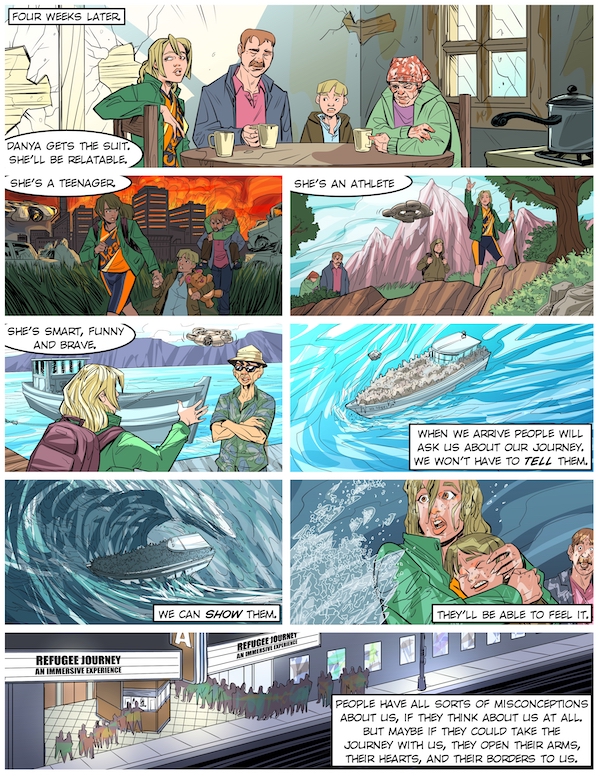
My future—let me show you it
“We’re all immigrants to the future; none of us is a native in that land.” At least, that’s what Marina Gorbis, our executive director here at Institute for the Future says, paraphrasing cultural anthropologist Margaret Mead. Marina thinks we should look at the future through the eyes of newbies—ready to explore, to learn, to do things differently.
Whenever you enter unfamiliar territory, it helps to have a guidebook, and a guide. Your guidebook to the world of 2026 is this volume of Future Now. Your guide is me.
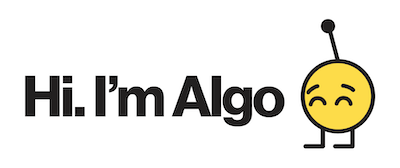 “Wait, who are you, again?” you might be asking. Sorry, should’ve introduced myself. I’m Algo, a bot created from the collective intelligence of the Tech Horizons’ research staff.
“Wait, who are you, again?” you might be asking. Sorry, should’ve introduced myself. I’m Algo, a bot created from the collective intelligence of the Tech Horizons’ research staff.
You'll see me pop up throughout this volume of Future Now to offer additional information, share an insight, or provide more context. You’ll find me popping up from time-to-time in the margins of articles, and at the end of each section to highlight the big takeaways. For now, my guidance is geared for a broad audience. And, unfortunately, I can’t hear you when you ask me a question. But one day soon, I’ll know a lot more about you, your interests and your knowledge gaps. I’ll be everywhere you are, ready to have a conversation with you anytime you need me. That’s because I’m a native of the world you’re about to enter, immigrant. Welcome to the future of ambient communications!
 FUTURE NOW—When Everything is Media
FUTURE NOW—When Everything is Media
In this second volume of Future Now, IFTF's print magazine powered by our Future 50 partnership, we explore the future of communications, tracing historical technology shifts through the present and focusing on the question: “What is beyond social media?”
Think of Future Now as a book of provocations; it reflects the curiosity and diversity of futures thinking across IFTF and our network of collaborators. This issue contains expert interviews, profiles and analyses of what today’s technologies tell us about the next decade, as well as comics and science fiction stories that help us imagine what 2026 (and beyond) might look and feel like.
About IFTF's Future 50
Every successful strategy begins with an insight about the future. Every organization needs to build the capacity to anticipate the future. The Future 50 is a side-by-side relationship with Institute for the Future; it’s a partnership focused on strategic foresight on a ten-year time horizon. With 50 years of futures research in society, technology, health, the economy, and the environment, IFTF has the perspectives, networks, signals, and tools to make sense out of the emerging future.
For More Information
For more information on IFTF's Future 50 Partnership and Tech Futures Lab, contact:
Sean Ness | sness@iftf.org | 650.233.9517



